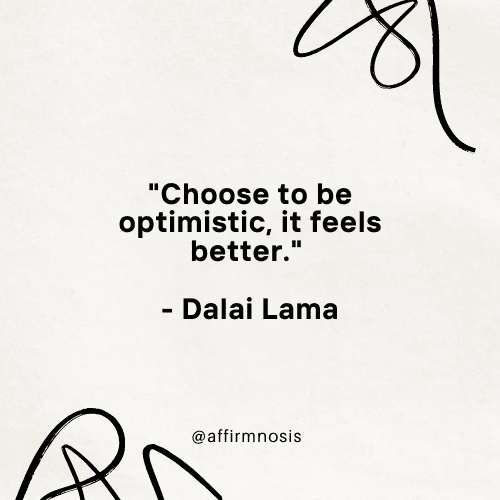Life is full of uncertainties, and it can be challenging to navigate through the ups and downs that come our way. Optimism is a powerful tool that can help us stay motivated and positive, but blindly approaching every situation with unwavering positivity can lead to disappointment and disillusionment.
That’s where cautious optimism comes in – a mindset that allows us to approach life with a positive outlook while still being realistic about potential challenges.
Definition of Cautious Optimism
Cautious optimism is defined as the ability to maintain a positive, hopeful outlook on life while also acknowledging potential obstacles or setbacks. It’s a mindset that encourages individuals to take calculated risks, set realistic goals, and approach challenges with an open mind.
Cautious optimists understand that life is not always perfect, but they have confidence in their ability to handle whatever comes their way.
The Importance of Cautious Optimism in Daily Life
Maintaining a cautious optimistic mindset has numerous benefits in daily life. For starters, it allows individuals to approach each day with positivity and enthusiasm, which can help increase motivation and productivity levels.
When we believe in ourselves and our abilities, we’re more likely to take actions towards achieving our goals.
Another benefit of cautious optimism is improved mental and emotional well-being. By embracing a hopeful outlook on life while also acknowledging potential risks or challenges, individuals are less likely to become overwhelmed by negative thoughts or emotions when things don’t go as planned.
Overall, cautious optimism strikes the balance between being overly optimistic (which can lead to disappointment) or overly negative (which can harm mental health). It encourages individuals to approach situations realistically while believing in their ability to overcome obstacles – making it an important mindset for success both personally and professionally.
The Benefits of Cautious Optimism
Positive Outlook on Life
Cautious optimism can lead to a positive outlook on life. When you practice cautious optimism, you acknowledge the potential risks and challenges in any situation but choose to focus on the possibilities and opportunities instead of letting fear and doubt take over.
This mindset allows you to approach life with a sense of hope and resilience, even in difficult circumstances.
A positive outlook can also improve your relationships with others. People are drawn to those who radiate positivity, and when you have a more optimistic outlook, it is easier to connect with others and build strong relationships based on mutual trust and respect.
Increased Motivation and Productivity
Cautious optimists tend to be more motivated and productive than those who are overly pessimistic or blindly optimistic. This is because they understand that success requires effort, but they also believe that their efforts will pay off in the end.
Cautious optimism helps individuals maintain focus on the task at hand by providing them with an underlying belief that their hard work will ultimately pay off. It encourages people to set realistic goals for themselves which they are more likely to achieve, keeping them motivated along the way.
Better Decision-Making Skills
When making decisions, cautious optimists consider both potential risks as well as possibilities before coming up with a conclusion. This allows them to make informed decisions that weigh all options effectively reducing the chances of failure or disappointment.
Additionally, this mindset encourages individuals to be proactive rather than reactive when faced with unexpected challenges or setbacks. Instead of getting overwhelmed by obstacles, cautious optimists remain focused on identifying solutions leading them towards better decision-making.
Improved Mental And Emotional Well-Being
The benefits of cautious optimism go beyond just performance at work or problem-solving abilities; it also has profound implications for an individual’s mental and emotional well-being. Cautious optimism can help reduce feelings of stress and anxiety by allowing individuals to maintain a positive outlook, even in challenging situations.
Studies have also shown that people who practice cautious optimism tend to be more resilient when faced with adversity. They are better equipped to handle setbacks, which can ultimately lead to greater self-confidence and a more positive outlook on life.
Furthermore, cautious optimists tend to have lower levels of depression than pessimists or those who are overly optimistic. This is because they are less likely to get bogged down by negative thoughts or feelings of hopelessness.
The Risks of Blind Optimism
Ignoring potential problems or risks
While optimism can be a positive force, when it becomes blind, it can lead to significant risks. Ignoring potential problems or risks is one of the most significant dangers of blind optimism.
When we focus solely on the positive aspects of a situation, we may overlook important details that could negatively impact the outcome.
For example, imagine that you are starting a new business venture. While optimism and excitement for your idea can be helpful, ignoring potential market challenges or competitive factors could derail your plans.
Blind optimism might lead you to believe that everything will work out perfectly without taking into account any potential risks. It is vital to maintain an objective view of the situation and consider both positive and negative aspects before making any decisions.
Overconfidence leading to poor decision-making
Blind optimism can also lead to overconfidence in our abilities, which can cause us to make poor decisions. When we have too much faith in ourselves or our ideas, we may not take the time to thoroughly evaluate all available options or seek advice from others who may have more experience.
Overconfidence can also cause us to take unnecessary risks that could have negative consequences.
For example, if you decide not to buy insurance for your new car because you believe nothing will happen to it, you leave yourself vulnerable in case of an accident. It is essential to balance confidence with caution and seek input from others before making any significant decisions.

Disappointment and disillusionment if things don’t go as planned
Blind optimism can cause disappointment and disillusionment when things don’t go as planned. While it’s essential always to remain positive and hope for the best outcomes, when we rely entirely on optimistic thinking without considering potential setbacks or obstacles along the way—the resulting failure can be particularly difficult.
For instance, if you are too optimistic about a project’s outcome and don’t plan for contingencies, you may find yourself unprepared when things don’t go as planned. As a result, you could become demotivated and disappointed.
It’s essential to maintain a realistic outlook on situations and consider all potential outcomes, both positive and negative. This way, even if things don’t go as planned, we can still maintain our optimism while also having a backup plan in place.
Strategies for Practicing Cautious Optimism
Cautious optimism is a delicate balance between looking at things positively while also being aware of potential challenges and risks. To practice it successfully, there are several strategies you can apply.
Evaluate the Situation Objectively
One of the most important aspects of practicing cautious optimism is to evaluate a situation objectively. This means taking an unbiased look at the facts and avoiding any preconceived notions or assumptions.
By doing so, you can gain a clearer understanding of what is really going on and make informed decisions based on actual information rather than speculation or conjecture.
For instance, if you’re considering starting your own business, it’s essential to conduct thorough research to determine whether there’s a market for your product or service.
You may be optimistic about your idea, but it’s crucial to gather data that supports your concept. Evaluating the situation objectively helps you realize what factors need consideration before proceeding with that idea.
Consider Potential Risks and Challenges
It can be tempting to focus solely on positive outcomes when approaching new endeavors; however, truly practicing cautious optimism means acknowledging potential risks and challenges as well. When embarking on any project or goal, take stock of everything that could go wrong and consider possible solutions beforehand.
For example, suppose you’re planning a hiking trip in an area prone to harsh weather conditions. In that case, it may be wise to research weather patterns for your planned trip dates ahead of time and plan accordingly by packing essential gear such as waterproof clothing or shelter in case of sudden storms.
Set Realistic Goals And Expectations
Another critical strategy when practicing cautious optimism is setting realistic goals and expectations. While being ambitious is admirable, setting unrealistic expectations can lead to disappointment when things don’t go as planned.
For instance, if you’re planning on running a marathon, it’s essential to set reasonable goals regarding training, diet, and pacing yourself. Setting realistic expectations increases your chances of success while also keeping you motivated by providing you with achievable milestones.
Focus on Solutions Rather Than Problems
Focusing on solutions rather than problems is a hallmark of practicing cautious optimism. When presented with challenges or obstacles, cautious optimists don’t dwell on the negatives; instead, they search for ways to overcome them.
For instance, if you’re struggling with a work project and keep running into roadblocks in one area, try shifting your focus to another aspect of the project where you can make progress. Practicing this mindset helps shift your perspective from seeing problems as insurmountable to seeing them as opportunities for growth and creativity.
Practicing cautious optimism involves evaluating situations objectively, considering potential risks and challenges ahead of time, setting realistic goals and expectations while focusing on solutions rather than problems. By implementing these strategies in daily life situations amplifies the benefits of being optimistic without overlooking potential downsides.
Real-Life Examples of Cautious Optimism in Action
Successful Entrepreneurs Who Take Calculated Risks
One of the most common examples of cautious optimism in action can be seen among successful entrepreneurs. Many entrepreneurs have a positive outlook on the future, but they also understand the importance of taking calculated risks.
For example, before launching a new product or service, they research their target market and assess potential demand. They also evaluate potential risks and challenges, such as competition or regulatory hurdles.
By taking these steps, entrepreneurs can approach their business with cautious optimism. Another key aspect of cautious optimism among entrepreneurs is their willingness to pivot when necessary.
Often, start-ups need to adjust their strategy based on feedback from customers or changes in the market. A cautious optimist will take this feedback seriously and make changes as needed while still remaining optimistic about the future success of their business.
Examples of successful entrepreneurs who practice cautious optimism include Sara Blakely, founder of Spanx, who took calculated risks in marketing her product and carefully managed her finances before expanding her business.
Another example is Elon Musk, who has taken bold risks with SpaceX and Tesla but also understands the importance of careful planning and preparation.
Athletes Who Train Hard But Also Prepare for Setbacks
Athletes are another group that often demonstrates cautious optimism in action. They have a positive outlook on their ability to perform well but also understand that setbacks are inevitable in sports.
For example, athletes will train hard to improve their skills but also prepare for potential injuries by practicing injury prevention techniques or having a plan for rehabilitation if an injury occurs. Athletes who practice cautious optimism are resilient when facing setbacks because they are prepared both physically and mentally to handle challenges.
They maintain a positive attitude even when things don’t go as planned because they know that setbacks are temporary and there is always room for improvement.
Examples of athletes who demonstrate cautious optimism include Kobe Bryant, who faced many setbacks throughout his career but continued to work hard and maintain a positive attitude, and Serena Williams, who has faced injuries and health issues but continues to push herself and remain optimistic about her ability to compete at the highest level.
Scientists Who Approach Research with an Open Mind
Scientists are another group that often demonstrates cautious optimism in action. They have a positive outlook on the potential for discovery and innovation but also understand the importance of considering potential limitations or challenges in their research. Scientists who practice cautious optimism approach their work with an open mind.
They consider all possibilities and are willing to adjust their hypothesis based on new data or information. At the same time, they carefully evaluate potential risks associated with their research, such as ethical concerns or limitations in technology.
Examples of scientists who practice cautious optimism include Neil deGrasse Tyson, who has a passion for scientific discovery but also understands the importance of careful evaluation of evidence and data.
Another example is Jane Goodall, whose ground-breaking research on chimpanzees was conducted with a deep respect for these animals’ well-being and environment.
Overall, these real-life examples demonstrate that cautious optimism is not only possible but also essential for success in various fields. By balancing positivity with careful consideration of risks and challenges, individuals can achieve great things while still maintaining a realistic perspective on what is possible.
The Importance of Balancing Optimism with Caution in Everyday Life
Balancing optimism with caution is essential for success in many areas of life. Whether it’s starting a new business venture, pursuing personal goals, or managing relationships with others, an overly optimistic or pessimistic approach can lead to unwise decisions or missed opportunities.
On the other hand, when individuals approach situations with both enthusiasm and awareness of potential challenges or risks, they can make more informed decisions that lead to positive outcomes. For this reason, practicing cautious optimism is not only beneficial but also necessary for achieving long-term success and happiness.
By finding ways to balance positivity with realism in everyday life, individuals can create a foundation for growth and achievement that will serve them well for years to come. While it may be tempting to adopt an overly optimistic or pessimistic outlook on life at times, taking a more balanced approach through cautious optimism is likely to yield greater rewards.
Whether you’re facing a new challenge at work or embarking on a personal journey towards your dreams and goals – remember that combining positivity with careful consideration is key to achieving long-term success.
So go ahead – embrace your inner optimist while staying grounded in reality – you might be surprised at what you can achieve!
Quotes on optimism, caution, and balanced perspectives.
- “Optimism is the faith that leads to achievement. Nothing can be done without hope and confidence.” – Helen Keller
- “A pessimist sees the difficulty in every opportunity; an optimist sees the opportunity in every difficulty.” – Winston Churchill
- “I am an optimist. It does not seem too much use being anything else.” – Winston Churchill
- “The only thing that makes life possible is permanent, intolerable uncertainty; not knowing what comes next.” – Ursula K. Le Guin
- “In the long run, the pessimist may be proved right, but the optimist has a better time on the trip.” – Daniel L. Reardon
- “Optimism is essential to achievement and it is also the foundation of courage and true progress.” – Nicholas M. Butler
- “Choose to be optimistic, it feels better.” – Dalai Lama
- “Beware the barrenness of a busy life.” – Socrates
- “The wise man in the storm prays to God, not for safety from danger, but for deliverance from fear.” – Ralph Waldo Emerson
- “The best way to predict the future is to create it.” – Peter Drucker
- “Optimism is a strategy for making a better future. Because unless you believe that the future can be better, you are unlikely to step up and take responsibility for making it so.” – Noam Chomsky
- “The only limit to our realization of tomorrow will be our doubts of today.” – Franklin D. Roosevelt
- “The future belongs to those who believe in the beauty of their dreams.” – Eleanor Roosevelt
- “The greatest discovery of all time is that a person can change his future by merely changing his attitude.” – Oprah Winfrey
- “The first step towards getting somewhere is to decide you’re not going to stay where you are.” – J.P. Morgan
- “The only way to do great work is to love what you do.” – Steve Jobs
- “The only thing standing between you and your goal is the story you keep telling yourself as to why you can’t achieve it.” – Jordan Belfort
These quotes emphasize the power of optimism, the importance of caution, and the potential for creating a better future through a balanced perspective.
20 affirmations that would help with Cautious Optimism
- “I am capable of finding the balance between hope and caution.”
- “I will continue to hope for the best, while being prepared for the unexpected.”
- “I am not naive; I am optimistically cautious, and that’s my strength.”
- “I am confident in my ability to handle whatever comes my way.”
- “It’s okay to dream big while keeping my feet grounded in reality.”
- “I am capable of making wise decisions that consider both the potential risks and benefits.”
- “I choose to look at the positive side while acknowledging the potential negatives.”
- “I am not ruled by fear, but I respect its role in guiding my actions.”
- “I have the courage to hope, and the wisdom to be cautious.”
- “I am not pessimistic, I am realistically optimistic.”
- “I choose to see the glass as half full, but I am also aware of its emptiness.”
- “My cautious optimism helps me navigate life’s challenges with a balanced mindset.”
- “I am capable of balancing optimism with a realistic perspective.”
- “I am prepared for the worst but I expect the best.”
- “I have the strength to face reality, and the hope to envision a better future.”
- “I choose to be hopeful, while also being prepared and aware.”
- “My optimism is grounded in reality, and that makes it even stronger.”
- “I believe in positive outcomes, but I am not blind to possible obstacles.”
- “I embrace the future with open eyes and a hopeful heart.”
- “I am an optimist who carries an umbrella, prepared for both sunshine and rain.”




























































